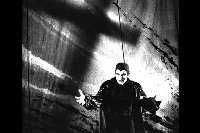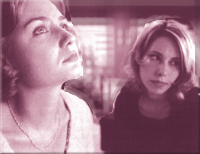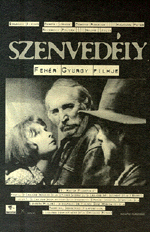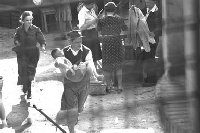 |
Vol 1, No 25
13 December 1999 |
|
|
Hungarian New Waves New trends in Hungarian cinema at London's ICA Andrew J Horton Hungarian cinema rose to prominence in Western eyes on the back of the 1960s New Wave. Now, thirty years later, the term New Wave is being resuscitated to describe the Hungarian cinema of the 1990s. The Institute of Contemporary Arts (ICA) in London, in honour of some of this decade's most recent films, organised a mini-retrospective of Hungarian New Waves which contrasted a master who rose to fame in the 1960s with the new breed of Hungarian directors. The ICA rather cheekily started its selection with a showing of Istvan Szabo's Mephisto (1981), based on Klaus Mann's novel of the same name. Although a much-loved film and one that is ever-welcome on London's screens, Szabo's Faustian tale of genius and power is hardly New Wave. Perhaps thematically, a more logical choice would have been his Almodozasok kora (The Age of Day Dreaming, 1964) or Apa (Father, 1966), true works of the the first New Wave and ones which rarely get screened, least of all in the UK.
Szabo himself made a rare public appearance for a discussion with the film historian Peter Hames about his life, Hungarian history and his films. Szabo agreed with Hames that his films are often about identity, but, more importantly that they are about the battle for security. Speaking specifically about his "Central European trilogy" (which started with Mephisto), Szabo said that the films are "about fights to reach to the feeling of security through compromises - bad compromises." However in suggesting this, Szabo also offered a linking theme which runs through all his diverse films, from intensely Hungarian works like Edes Emma, Draga Bobe to his more international and large-scale epics, such as Mephisto. New kid on the block Alongside the name of Szabo, the rest of the directors represented in the short season were relative unknowns. Perhaps the director who has received most exposure in the UK is Tamas Sas, through his award-winning debut Presszo (Espresso, 1997) and his popular smash Kalozok (Pirates aka You or Me, 1998). The ICA rightly chose to screen the more innovative of the two, Presszo. Apart from the opening and closing scenes which overlap with the credits, Presszo is shot entirely from one fixed camera angle - a well-positioned corner of a Budapest cafe. Cafe culture has always been important in Hungarian social and intellectual circles, and even when Communism stripped cafes of their high-brow pretensions and position as a focus for the intelligentsia, the cafe remained an important centre for social gatherings.
Sas's homage to the cafe culture is successful through its ability to capture the rhythm and texture of Hungarian conversation of the 1990s. English-speaking viewers following the subtitles miss out on this aspect of the film, particularly since the subtitles have been substantially toned down. Whereas in English there are four-lettered words, in Hungarian there are what Dr Sandor Striker of the Hungarian Cultural Centre in London describes as "four-word sentences." Much of this ability of Hungarians to swear inventively has been demoted to a series of rather pale and unimaginative socially acceptable equivalents in English. Presszo is interesting in that it does not shy away from representing conversation as it really happens, including the previously rather taboo subject of how women swear when they are together. Indeed, emigre Hungarians who watch the film after not being in Hungary for some time are frequently shocked at how much the language has changed. This is not to say that the film is without charm for the English-speaking viewer. Perceptive and penetrating, Presszo is at some level a portrait of the overlapping private lives of people all over the world. As an incidental footnote to the success of Presszo, it is interesting to consider Kalozok, which, unlike its predecessor, wholly fails to capture the youth culture, either in its inflexions of speech or its music or its attitudes. This strange contrast might be explained by the presence of the well-known writer/actor Gabor Nemeth on the credits of Presszo as co-screenplay writer with Sas. The postman rings again Presszo won the jury prize for best screenplay at the 29th Hungarian Film Week in Budapest but might have walked off with more, had it not been for Gyorgy Feher's Szenvedely (Passion, 1998), which grabbed a number of awards including the Grand Jury Prize, best director and the Gene Moskowitz Prize, awarded by foreign film critics at the festival.
Feher heightens atmosphere with a lean script, tense pace and haunting black and white photography (which was also awarded a prize in Budapest). His mastery of the medium clearly comes out in the middle passages of the film when, in prison, the prosecutor sets the lovers against each other to undermine "the perfect murder." But Feher's command is incomplete and whilst Szenvedely might have some of the most electric moments of all the four film versions of The Postman Always Rings Twice its ending is disappointingly weak and seemingly undercuts the film noir ethic with its triteness and simplicity. Goldfinger Geza Beremenyi also pins his events down to a precise location and era to tell an old tale. His Eldorado (The Midas Touch, 1988) is an ambitious period drama which spans the time from the end of World War II to the Hungarian Uprising of 1956, and is largely set in Budapest's Teleki Square fleamarket. Monori (Karoly Eperjes) is a black-market trader who uses his wiles to establish himself as the King of the Fleamarket.
Beremenyi is aiming for an epic quality to his work which combines attention to detail of the ordinary lives of those on the fringes of society with a mythic allegorical element to its moral - a Mephisto for the age of capitalism, perhaps. Despite fine acting and a convincing recreation of the late 1940s and early 1950s, Eldorado fails to punch as hard of Szabo's moral tale. Its mixture of the specific and the universal sit uneasily beside each other and the film emerges as a good one for Hungarian film fans, but one which is unlikely to appeal to a wider audience. New directions Far more convincing is Janos Szasz's Witman fiuk (The Witman Boys, 1997), another period drama, this time set in the last years of the Austro-Hungarian Empire (although external events have little bearing on this chamber piece). Witman fiuk is another literary adaptation, this time from a short story called "Anyagyilkossag" (translated as "Matricide" [1]) by Geza Csath (1887-1919). After the death of their father, the brothers Janos and Erno find themselves at a loss at how to deal with their grief. Their mother does not cry at the funeral and everyone's response seems stiff and formal to this formative and emotional event for them.
When their mother takes in a new lover, the distraught duo lose faith in family love and seek solace elsewhere, something they eventually find in Iren, a prostitute who gives them the maternal / sexual attention they seek. Their desire to validate Iren as their fount of emotional care leads to them murdering their mother.
If new Hungarian cinema is going to be remembered for anything in years to come, then Witman fiuk is likely to stand out as a reference point. With its skilful and sensitive recreation of the stifling values of a bygone time and the cruel but sensitive inner workings of the adolescent mind, Witman fiuk marks a new direction in Hungarian film. Overturning the comedy ethos which has prevailed throughout much of the decade in the films of the likes of Robert Koltai, Peter Timar and even Tamas Sas, it is a return to psychologising and film artistry. Szasz, though, has learnt the lessons of the 1990s well, and Witman fiuk never alienates its audience with its vision and never forgets that the viewer has paid good money to have an "experience." Szasz knows he has to compete with entertainment movies and does so without compromising his values or the impact of his story. Although Witman fiuk is an excellent film, it has to be said that it so easily stands out from the crowd as it was made in what for Hungarian film will probably be remembered as a disappointing decade. However, Szabo, speaking at the ICA, was philosophical about the recent lack of success of the Hungarian film industry. Pointing out that around 5000 films are made around the globe each year he stated that:
In this light, although the 1990s have produced few Hungarian masterpieces, it cannot really be said to matter - we can still call it by Szabo's definition a great decade for Hungarian film. However, Szabo acknowledged that Hungarian film needed another language for the new times. Films like Witman fiuk just could be the start of this new voice Andrew J Horton, 13 December 1999 More on the directors in this article Click here for Andrew J Horton's review of the 1998 Szabo retrospective in London. Click here for Andrew J Horton's review of Janos Szasz's Temetes. Kinoeye on other recent Hungarian Films 6:3: Timar, Peter: 1998
Nyari mozi: Tolnai, Szabolcs: 1998 Simon Magus: Enyedi, Ildiko: 1997-98 Temetes: Szasz, Janos: 1997-98 Visszateres (Kicsi de nagyon eros 2): Grunwalsky, Ferenc: 1998
NOTE:
|
|
![]()
Copyright (c) 1999, 2000 - Central Europe Review and Internet servis, a.s.
All Rights
Reserved








